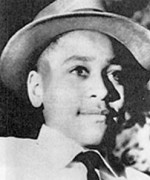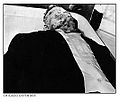A few days ago, Mr. Willie Louis died, aged 76. As an unimaginably frightened, incredibly brave young man, aged 18, he had testified at the trial of the killers of Emmett Till, who were found not guilty, though they were guilty. His name then was Willie Reed. He changed to Willie Louis, after having escaped in hiding from Mississippi and going to Chicago, where he lived “discreetly,” according to the Times, and worked as a hospital orderly.
I don’t think we ought to forget him, or what happened in 1955 near Money, Mississippi, when two white men beat the 14-year old Emmett Till to death for verbally insulting (as they saw it) a white woman. A boy who found himself in the wrong neighborhood.
You might wish to read this account of the trial by the important African American reporter James L. Hicks, which I published ten years in Archipelago, all the while remembering that, if we are indeed a nation of laws, not men, the laws, and their administration, are very often subject to the wilful interpretation of men. We might recall a recent trial in Florida, State of Florida v. George Zimmerman, in which an armed man who killed an unarmed youth (the age of Willie Reed as he was then), and was found not guilty of taking a life. We might recall the recent Supreme Court decision Shelby County v. Holder, which gutted our most important, far-reaching, successful civil rights legislation, the Voting Rights Act (1965).
Lives. Votes. Laws. Men.
“They Stand Accused by C-P Reporter:
Jimmy Hicks Charges Mss. Officials Aided Lynchers”
James L. Hicks, Cleveland Call and Post, October 8, 1955
New York, N.Y. — Here for the first time is the true story of what happened in the hectic five-day trial of two white men in Sumner, Mississippi, for the murder of 14-year-old Emmett Till of Chicago.
This story has never been written before. I did not write it in Mississippi for fear of bodily harm to myself, and to my colleagues.
No one else has written it because no one else in the capacity of a reporter lived as close to it as I did.
Looking back on it now, I am ashamed that I did not throw caution to the winds and at least try to get out the story exactly as it was unfolding to me. I’m convinced, however, that if I had tried this, I would not be here in New York to write this.
. . .
I finally charge that if Leroy Collins is brought forward at this date and given all opportunity to talk where he is assured that he is not in any danger, he will be able to tell where Henry Lee Loggins is and that the two of them will prove to be the two colored men who were seen on the truck the night of the murder by Moses Wright and Willie Reed.
I believe that Henry Lee Loggins is dead and that he was disposed of because he knew too much about the case.
These are serious charges. But I welcome this opportunity to write down the evidence on which they are based.
This is the fantastic story as lived by this reporter:
Above is a digitized image of a photograph of Emmett Till, aged 13, taken by his mother.
Here is a photograph of Emmett Till’s encoffined remains, displayed openly at his mother’s insistence.
(Both images via Wikipedia, judged as fair use.)


You must be logged in to post a comment.